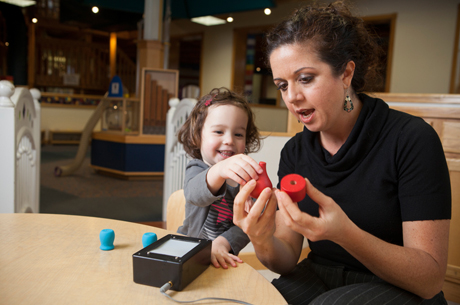Museum-University Partnerships Focused On Brain Research: STEM Professionals Share Their Thoughts
Tamar Kushnir, Professor and Director of Cornell University’s Early Childhood Cognition Laboratory, works with a young visitor on the Sciencenter’s floor. Photo courtesy of Lindsay France/Cornell University Photography.
This article was co-written by Donna DiBartolomeo, Director of Exhibits, Sciencenter, Michelle Kortenaar, Director of Education, Sciencenter, Jayatri Das, Chief Bioscientist, The Franklin Institute, and Holly Truitt, Executive Director, The University of Montana spectrUM Discovery Area.
When museums and universities form partnerships to inform and advance their work, the results can be mutually beneficial. Museum environments present a unique opportunity to engage public audiences with the products and processes of scientific research through exhibits and public programs. University researchers bring a wealth of content knowledge and skills to informal learning venues, and their research studies can have the potential to inform their museum collaborators.
We have developed museum-university partnerships that focus on cognitive science, neuroscience, the study of the brain, and how people learn - all fields of research that can impact and inform the museum field in significant ways. Our partnerships focusing on these areas have been particularly fruitful because of their ability to convey current scientific understanding of the brain, and their potential to bring fresh ideas for effective educational approaches through an enhanced understanding of metacognition and brain-based learning.
At the 2015 ASTC conference in Montreal, we shared experiences and thoughts from our respective museum-university partnerships, and how our partnerships have informed exhibits, programs, and research, as well as strategies for collaboration. The Sciencenter and Cornell University’s Early Childhood Cognition Laboratory work together to develop exhibits and programs that use current research into children’s learning to enhance the experiences of both children and caregivers. The University of Montana spectrUM Discovery Area and Center for Structural and Functional Neuroscience (CSFN) collaborated to create an exhibition and working neuroscience lab on the museum floor, staffed by CSFN researchers, museum educators, and a team of college and high school educators. The Franklin Institute and the Center for Neuroscience & Society (CNS) at the University of Pennsylvania collaborated on an exhibition about the human brain, teacher professional development activities about brain-based learning, student workshops, and a high school level elective course curriculum that fosters engagement in and discussion of neuroethics.
The results of these museum-university partnerships have been positive, and continued collaboration is ensured once a cooperative framework is established. But as with all projects, we have learned some lessons that we would like to share. The course of cross-institutional collaborations is not linear, and requires an iterative process of planning, aligning goals and missions, and adapting to the needs of the partnering organizations. It is important to identify a shared vision at the beginning of the project, and invest time in learning about each other’s foci, purposes and cultures. Once a mutually beneficial understanding is established, co-creation can begin in an exciting and productive way, with the potential for long-term benefits for both organizations.
Although our partnerships represent specific collaborations in the field of brain research, the model of museum-university partnerships can be used with many other organizations and areas of scientific research. An important takeaway from our work is that public audiences ultimately benefit from such collaborations because the public can access scientific content in exhibits and public programs in more captivating ways. Furthermore, we have seen that public audiences benefit when museum-university partnerships incorporate data collection to inform research, develop content for specific exhibit areas, or implement collaborative programs that simultaneously meet the goals of each partner. Engaging the public with research, and disseminating findings through museums and science centers allows the academic community to effectively reach a broader audience while also advancing the museum field.
